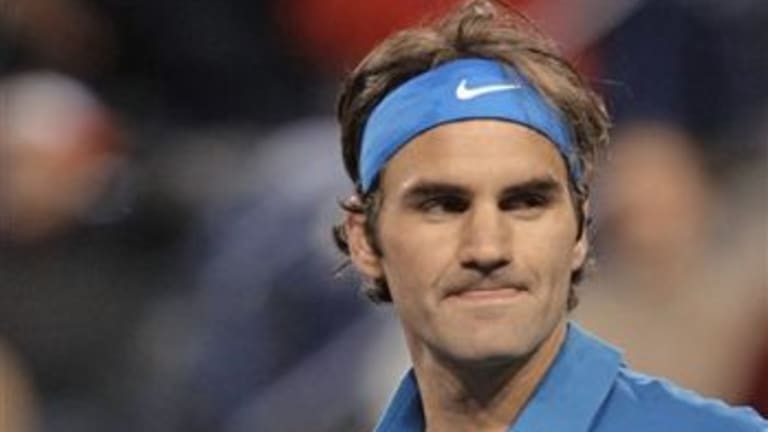INDIAN WELLS, CALIF.—“I have the ability to frustrate my opponents no matter who I’m playing.”
This was how John Isner described his game after his epic win over world No. 1 Novak Djokovic today. How right he is. It doesn’t matter what you're ranked, No. 1 or No. 1001, Isner is the great leveler, the great equalizer. Whoever you are, he makes you play on his terms—you do what you can do, and then you hope. Technically, you still have the racquet in your hand, but it may not feel that way the whole time.
Watching Isner squeak past Djokovic, despite winning 11 fewer points, 7-6 (7), 3-6, 7-6 (5) today, I began trying to imagine all of the various ways that the 6-foot-9 American could get into a player’s head. He was, if body language means anything, obviously in his opponent’s today. Djokovic stood with his hands on his hips, he threw them in the air, he stared at the sky, he stared at his box, he stared at the court. He couldn’t, despite all of his best efforts and quite a few chances, get over the last hump today. It’s not surprising that Djokovic walked straight into the interview room afterward, still in his playing clothes, still wound tight, still with shoulders scrunched together. It's also not surprising that the third word out of his mouth was “frustrating.”
As in, “It’s frustrating when somebody serves over 70 percent of first serves in with that angle and that speed and accuracy.”
—Frustration No. 1: You must think more on your serve
Isner can struggle with his first-serve return, but he has developed a devastating, if erratic, go-for-broke forehand return on second serves. If he hits it right, the point’s his. So do you take a chance with your first serve and risk having to face that forehand on the second ball? This adds an extra thought in a player’s head as he steps up to the line—never a good thing.
Isner hits that forehand moving to his left, which forces the server to make another decision. Do you throw in a standard second serve toward his backhand and risk having him run around it and kill you? Or do you take a chance in the ad court and try the more unnatural second serve up the T? The question troubled Djokovic at crucial moments today. He tried the tricky one up the T at 4-5 in the first-set tiebreaker and double faulted. In the third-set breaker, at 2-3, he stuck to the standard second serve to the backhand side. That didn’t work, either. Isner jumped around and drilled it for a winner; it was the mini-break that won him the match. For all the talk of Isner’s serve and Djokovic’s return, it was Isner’s return, of all shots, that won it for him at the end.
—Frustration No. 2: You must make every return you get your racquet on
At 4-4 in the third set, Djokovic stung a brilliant running backhand pass for 0-15. Here was a possible opening. Isner kicked his next serve wide, but Djokovic was on it with another backhand. He snapped it crosscourt, but just over the sideline. He was distraught. He didn’t want to believe it had been out. It seemed like he was about to cry, “Shouldn’t I get credit for almost getting his serve back?” The feeling is understandable. You get so few clean return looks that you simply can’t miss them.
—Frustration No. 3: You must play steadily, while he’s free to do whatever he wants
The longer the rallies went, the better Djokovic’s chances, which meant that his smartest play was just to move the ball around; going for more was riskier, without holding out any greater reward. What makes this tougher than normal is the knowledge, because of Isner’s serve, that any error by you during your own service game could spell your doom for that set. This can easily make you play tentatively. Meanwhile, Isner has the luxury of taking as many big cuts as he needs, and making plenty of errors along the way, as long as he connects a few times per set. He gets to have all the fun.
As Djokovic said: “You have to judge yourself as the match goes on if you want to be aggressive on the ground strokes or you want to be patient. So you kinda have to have a little bit of both.” Sounds like a precarious balance to maintain.
—Frustration No. 4: Isner hits some shots so poorly that they look like they came off of a weekend hacker’s racquet. When Isner sends one into the sky or the bottom of the net, a player like Djokovic must (a) wonder how he could ever lose to this guy; and (b) gain some hope. It’s almost always false hope, unfortunately. Isner has an amazing knack for hitting two shanks and then coming back, undaunted, to hit two winners with the same shot.
Frustration No. 5: It may not matter much at all how well you play.
It took Djokovic just a few words to sum up his day: “I thought I played a really good match. I knew I had to stay patient and wait for the chance. I had some chances. I didn’t use them.”

